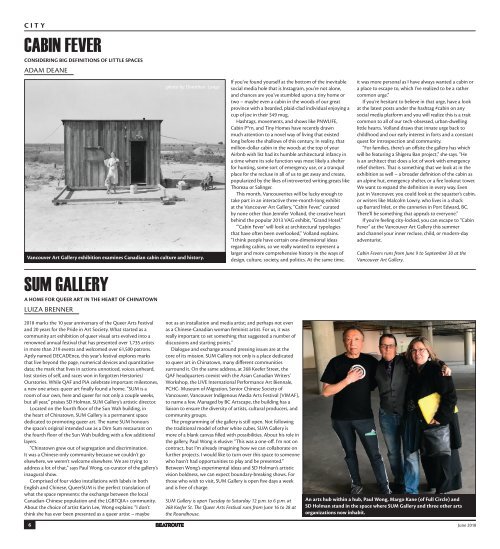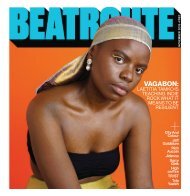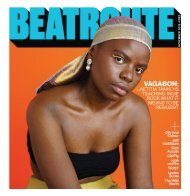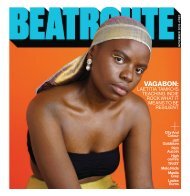BeatRoute Magazine BC Print Edition June 2018
BeatRoute Magazine is a monthly arts and entertainment paper with a predominant focus on music – local, independent or otherwise. The paper started in June 2004 and continues to provide a healthy dose of perversity while exercising rock ‘n’ roll ethics. Currently BeatRoute’s AB edition is distributed in Calgary, Edmonton (by S*A*R*G*E), Banff and Canmore. The BC edition is distributed in Vancouver, Victoria and Nanaimo. BeatRoute (AB) Mission PO 23045 Calgary, AB T2S 3A8 E. editor@beatroute.ca BeatRoute (BC) #202 – 2405 E Hastings Vancouver, BC V5K 1Y8 P. 778-888-1120
BeatRoute Magazine is a monthly arts and entertainment paper with a predominant focus on music – local, independent or otherwise. The paper started in June 2004 and continues to provide a healthy dose of perversity while exercising rock ‘n’ roll ethics.
Currently BeatRoute’s AB edition is distributed in Calgary, Edmonton (by S*A*R*G*E), Banff and Canmore. The BC edition is distributed in Vancouver, Victoria and Nanaimo. BeatRoute (AB) Mission PO 23045 Calgary, AB T2S 3A8 E. editor@beatroute.ca BeatRoute (BC) #202 – 2405 E Hastings Vancouver, BC V5K 1Y8 P. 778-888-1120
You also want an ePaper? Increase the reach of your titles
YUMPU automatically turns print PDFs into web optimized ePapers that Google loves.
CITY<br />
CABIN FEVER<br />
CONSIDERING BIG DEFINITIONS OF LITTLE SPACES<br />
ADAM DEANE<br />
photo by Dorothea Lange<br />
Vancouver Art Gallery exhibition examines Canadian cabin culture and history.<br />
SUM GALLERY<br />
A HOME FOR QUEER ART IN THE HEART OF CHINATOWN<br />
LUIZA BRENNER<br />
If you’ve found yourself at the bottom of the inevitable<br />
social media hole that is Instagram, you’re not alone,<br />
and chances are you’ve stumbled upon a tiny home or<br />
two – maybe even a cabin in the woods of our great<br />
province with a bearded, plaid-clad individual enjoying a<br />
cup of joe in their $49 mug.<br />
Hashtags, movements, and shows like PNWLIFE,<br />
Cabin P*rn, and Tiny Homes have recently drawn<br />
much attention to a novel way of living that existed<br />
long before the shallows of this century. In reality, that<br />
million-dollar cabin in the woods at the top of your<br />
Airbnb wish list had its humble architectural infancy in<br />
a time where its sole function was most likely a shelter<br />
for hunting, some sort of emergency use, or a tranquil<br />
place for the recluse in all of us to get away and create,<br />
popularized by the likes of introverted writing greats like<br />
Thoreau or Salinger.<br />
This month, Vancouverites will be lucky enough to<br />
take part in an interactive three-month-long exhibit<br />
at the Vancouver Art Gallery, “Cabin Fever,” curated<br />
by none other than Jennifer Volland, the creative heart<br />
behind the popular 2013 VAG exhibit, “Grand Hotel.”<br />
“’Cabin Fever’ will look at architectural typologies<br />
that have often been overlooked,” Volland explains.<br />
“I think people have certain one-dimensional ideas<br />
regarding cabins, so we really wanted to represent a<br />
larger and more comprehensive history in the ways of<br />
design, culture, society, and politics. At the same time,<br />
it was more personal as I have always wanted a cabin or<br />
a place to escape to, which I’ve realized to be a rather<br />
common urge.”<br />
If you’re hesitant to believe in that urge, have a look<br />
at the latest posts under the hashtag #cabin on any<br />
social media platform and you will realize this is a trait<br />
common to all of our tech-obsessed, urban-dwelling<br />
little hearts. Volland draws that innate urge back to<br />
childhood and our early interest in forts and a constant<br />
quest for introspection and community.<br />
“For families, there’s an offsite the gallery has which<br />
will be featuring a Shigeru Ban project,” she says. “He<br />
is an architect that does a lot of work with emergency<br />
relief shelters. That is something that we look at in the<br />
exhibition as well – a broader definition of the cabin as<br />
an alpine hut, emergency shelter, or a fire lookout tower.<br />
We want to expand the definition in every way. Even<br />
just in Vancouver, you could look at the squatter’s cabin,<br />
or writers like Malcolm Lowry, who lives in a shack<br />
up Burrard Inlet, or the canneries in Port Edward, <strong>BC</strong>.<br />
There’ll be something that appeals to everyone.”<br />
If you’re feeling city-locked, you can escape to “Cabin<br />
Fever” at the Vancouver Art Gallery this summer<br />
and channel your inner recluse, child, or modern-day<br />
adventurist.<br />
Cabin Fevers runs from <strong>June</strong> 9 to September 30 at the<br />
Vancouver Art Gallery.<br />
<strong>2018</strong> marks the 10 year anniversary of the Queer Arts Festival<br />
and 20 years for the Pride in Art Society. What started as a<br />
community art exhibition of queer visual arts evolved into a<br />
renowned annual festival that has presented over 1,735 artists<br />
in more than 219 events and welcomed over 61,500 patrons.<br />
Aptly named DECADEnce, this year’s festival explores marks<br />
that live beyond the page, numerical devices and quantitative<br />
data; the mark that lives in actions unnoticed, voices unheard,<br />
lost stories of self, and races won in forgotten Herstories/<br />
Ourstories. While QAF and PiA celebrate important milestones,<br />
a new one arises: queer art finally found a home. “SUM is a<br />
room of our own, here and queer for not only a couple weeks,<br />
but all year,” praises SD Holman, SUM Gallery’s artistic director.<br />
Located on the fourth floor of the Sun Wah building, in<br />
the heart of Chinatown, SUM Gallery is a permanent space<br />
dedicated to promoting queer art. The name SUM honours<br />
the space’s original intended use as a Dim Sum restaurant on<br />
the fourth floor of the Sun Wah building with a few additional<br />
layers.<br />
“Chinatown grew out of segregation and discrimination.<br />
It was a Chinese-only community because we couldn’t go<br />
elsewhere, we weren’t welcome elsewhere. We are trying to<br />
address a lot of that,” says Paul Wong, co-curator of the gallery’s<br />
inaugural show.<br />
Comprised of four video installations with labels in both<br />
English and Chinese, QueerSUM is the perfect translation of<br />
what the space represents: the exchange between the local<br />
Canadian-Chinese population and the LGBTQIA+ community.<br />
About the choice of artist Karin Lee, Wong explains: “I don’t<br />
think she has ever been presented as a queer artist – maybe<br />
6<br />
not as an installation and media artist; and perhaps not even<br />
as a Chinese-Canadian woman feminist artist. For us, it was<br />
really important to set something that suggested a number of<br />
discussions and starting points.”<br />
Dialogue and exchange around pressing issues are at the<br />
core of its mission. SUM Gallery not only is a place dedicated<br />
to queer art in Chinatown, many different communities<br />
surround it. On the same address, at 268 Keefer Street, the<br />
QAF headquarters coexist with the Asian Canadian Writers’<br />
Workshop, the LIVE International Performance Art Biennale,<br />
PCHC- Museum of Migration, Senior Chinese Society of<br />
Vancouver, Vancouver Indigenous Media Arts Festival (VIMAF),<br />
to name a few. Managed by <strong>BC</strong> Artscape, the building has a<br />
liaison to ensure the diversity of artists, cultural producers, and<br />
community groups.<br />
The programming of the gallery is still open. Not following<br />
the traditional model of other white cubes, SUM Gallery is<br />
more of a blank canvas filled with possibilities. About his role in<br />
the gallery, Paul Wong is elusive: “This was a one-off. I’m not on<br />
contract, but I’m already imagining how we can collaborate on<br />
further projects. I would like to turn over this space to someone<br />
who hasn’t had opportunities to play and be presented.”<br />
Between Wong’s experimental ideas and SD Holman’s artistic<br />
vision boldness, we can expect boundary-breaking shows. For<br />
those who wish to visit, SUM Gallery is open five days a week<br />
and is free of charge.<br />
SUM Gallery is open Tuesday to Saturday 12 p.m. to 6 p.m. at<br />
268 Keefer St. The Queer Arts Festival runs from <strong>June</strong> 16 to 28 at<br />
the Roundhouse.<br />
An arts hub within a hub, Paul Wong, Margo Kane (of Full Circle) and<br />
SD Holman stand in the space where SUM Gallery and three other arts<br />
organizations now inhabit.<br />
<strong>June</strong> <strong>2018</strong>


















